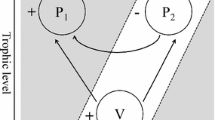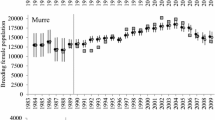Abstract
Changes in population size and structure depend not only on the internal dynamics of populations, but also on environmental coupling, human exploitation, and interaction with other species. Some of these factors are cyclic and predictable, while others are random. In some cases the effect of interactions is to destabilise the system and produce catastrophic changes, which are manifested as discontinuities. This paper reviews several models of marine populations which generate long‐term population changes, typically much longer than the generation time of the species involved. The output of these models is realistic and agrees with existing data, but in the absence of adequate time series it is not always possible to test or validate such models in a rigorous statistical sense. The paper concludes with a discussion of the role of such models in our understanding of long‐term changes in marine populations, and the practical implications of not always being able either to validate or falsify models needed for effective decisionmaking.
Similar content being viewed by others
References
H. Arancibia, L. Cubillos, D. Arcos, A.S. Grechina and L. Vilugron, The fishery of horse mackerel (Trachurus symmetricus murphyi) in the South Pacific Ocean, with notes on the fishery off Central-Southern Chile, Scientia Marina 59 (1995) 589–596.
G.A.P. Black, T.W. Rowel and E.G. Dawe, Atlas of the biology and distribution of the squids Illex illecebrosus and Loligo peali in the Northwest Atlantic, Can. Spec. Publ. Fish. Aquat. Sci. 100 (1987) 62.
P. Cabilio, D.L. DeWolfe and G.R. Daborn, Fish catches and longterm cycles in Northwest Atlantic fisheries: a nonlinear regression approach, Can. J. Fish. Aquat. Sci. 44 (1987) 1890–1897.
L.M. Dickie, Difficulties in interpreting trends in cod and haddock landings from the Eastern Scotian Shelf, ICNAF Res. Bull. 2 (1965) 80–82.
A.A. Elizarov, A.S. Grechina, B.N. Kotenev and A.N. Kuzetsov, Peruvian jack mackerel, Trachurus symmetricus murphyi, in the open waters of the South Pacific, J. Ichthyol. 33 (1993) 86–104.
FAO, Yearbook of fishery statistics: catches and landings (1992 and earlier).
D.A. Greenberg, A numerical model investigation of tidal power phenomena in the Bay of Funday and Gulf of Maine, Marine Geodesy 2 (1979) 161–187.
J.N. Kremer and S.W. Nixon, A Coastal Marine Ecosystem (Springer, Berlin, 1978) p. 217.
H. Lindeboom, W. van Raaphorst, J. Beukma, G. Cadée and C. Swennen, (Sudden) changes in the North Sea and Wadden Sea: Oceanic influences underestimated?, German J. of Hydrography, Supplement 2 (1995) 87–100.
K.R. Popper, The Logic of Scientific Discovery (3rd ed., Hutchinson, London, 1968).
W. Silvert, Book review, A Coastal Marine Ecosystem, Simulation and Analysis, by J.N. Kremer and S.W. Nixon, J. Fish. Res. Board Can. 36 (1979) 597–598.
W. Silvert, Amplification of environmental fluctuations by marine ecosystems, in: Oceanol. Acta. Proc. 17th European Marine Biological Symp. (1983) pp. 183–186.
W. Silvert, Model uniqueness, in: Towards the Inclusion of Fishery Interactions in Management Advice, ed. R. Mahon, Can. Tech. Rep. Fish. Aquat. Sci. 1347 (1985) pp. 132–135.
W. Silvert, Generic models of continental shelf ecosystems, in: Ecodynamics: Contributions to Theoretical Ecology, eds. W. Wolff, C.-J. Soeder and F.R. Drepper, Lecture Notes in Physics (Springer, Berlin, 1988) pp. 153–161.
W. Silvert, Experiments in benthic modelling, in: Report of the Workshop MODELLING THE BENTHOS, Yerseke, the Netherlands, 20–22 March 1991, eds. P.M.J. Herman and C.H.R. Heip, Delta Institute for Hydrobiological Research, Royal Netherlands Academy of Arts and Sciences, Comm. No. 538 (1991) pp. 175–188.
W. Silvert, Size-structured models of continental shelf food webs, in: Trophic Models of Aquatic Ecosystems, eds. V. Christensen and D. Pauly, ICLARM Cong. Proc. 26 (1993) pp. 40–43.
W. Silvert and W.R. Smith, The response of ecosystems to external perturbations, Math. Biosci. 55 (1981) 279–306.
W. Silvert and L.M. Dickie, Multispecies interactions between fish and fishermen, in: Multispecies Approaches to Fisheries Management Advice, ed. M.C. Mercer, Can. Spec. Publ. Fish. Aquat. Sci. 59 (1982) pp. 163–169.
W. Silvert and R.J.M. Crawford, The periodic replacement of one fish stock by another, in: Long Term Changes in Marine Fish Populations, eds. T. Wyatt and M.G. Larrañeta (1988) pp. 161–180.
A. Soutar and J.D. Isaacs, History of fish populations inferred from fish scales in anaerobic sediments off California, Calif. Mar. Res. Comm. CalCOFI 13 (1969) 63–70.
A. Soutar and J.D. Isaacs, Abundance of pelagic fish during the 19th and 20th centuries as recorded in anaerobic sediments of the Californias, U.S. Fish. Bull. 72 (1974) 257–273.
T. Wyatt and M.G. Larrañeta, Long Term Changes in Marine Fish Populations (Vigo, Spain, 1988) p. 554.
Author information
Authors and Affiliations
Rights and permissions
About this article
Cite this article
Silvert, W. The role of interactions in long‐term population cycles. Environmental Modeling & Assessment 2, 49–54 (1997). https://doi.org/10.1023/A:1019076319943
Issue Date:
DOI: https://doi.org/10.1023/A:1019076319943




